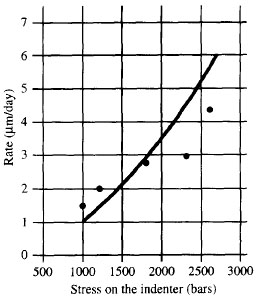| |||||||
|
|
|||||||
|
|
|||||||
| Pressure Solution and Pressure | |||||||
|
The efficiency of pressure solution generally increases with increasing pressure. For bed-parallel horizontal pressure solution seams, it is related to the thickness of the overburden or the burial depth. An increase of pressure on the grains has two consequences. On one hand, it decreases the water film thickness and degrades its transportation ability, which has a negative effect on the pressure solution rate. On the other hand, it increases the driving force for diffusion, the concentration gradient, which has a positive effect on the solution rate. It appears that under geological conditions, the effect of inclined concentration gradient dominates with increasing pressure and thus favors pressure solution. Gratier (1993) performed indenter experiments on the surface of a crystal of quartz. High temperature (350 degrees Celsius), high pressure (1000 to 3000 bars), and one molar sodium hydroxide are used in the experiments in order to increase the deformation rate so that the results can be observed in a reasonable time peroid. Renard et al. (1997) modeled the effect of pressure on the rate of pressure solution by the kinetics of dissolution, diffusion, and precipitation. Both Gratier and Ronard et al. reached the conclusion that increasing pressure increases the rate of pressure solution proportionally (Figure 1). | |||||||
| Reference: |
|||||||
| Gratier, J.P., 1993 Renard, F., Ortoleva, P., Gratier, J.P., 1997 |
|||||||
|
Readme | About Us | Acknowledgement | How to Cite | Terms of Use | Ⓒ Rock Fracture Knowledgebase |
|||||||
